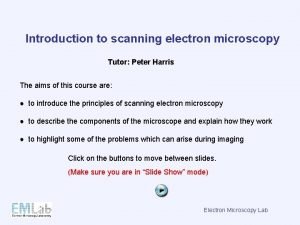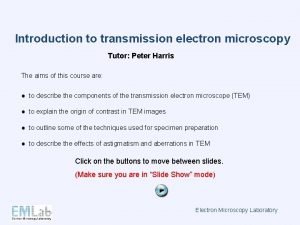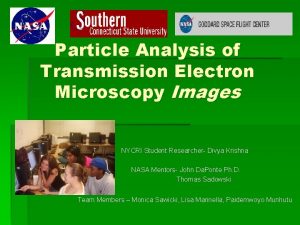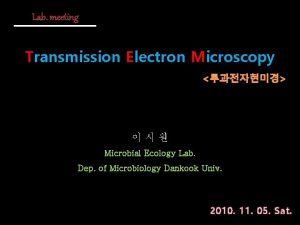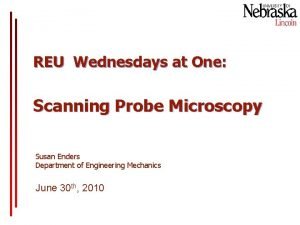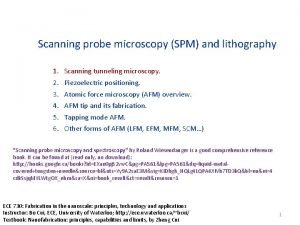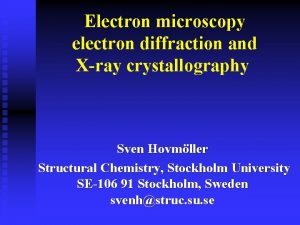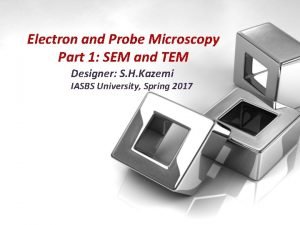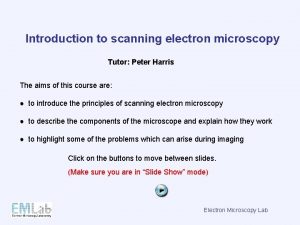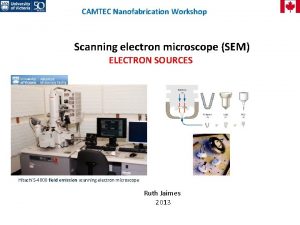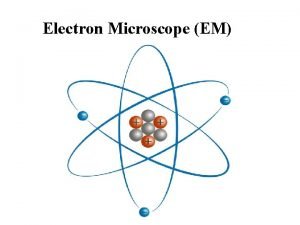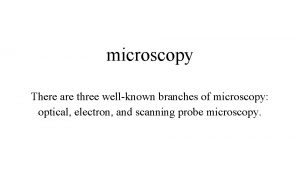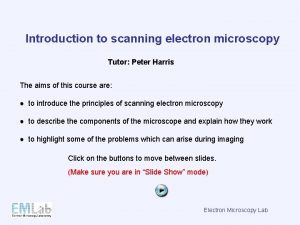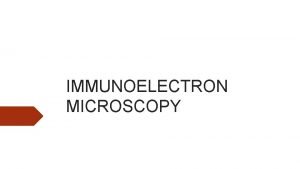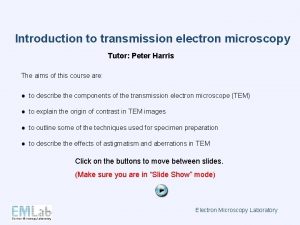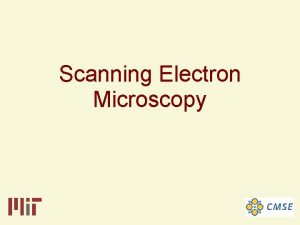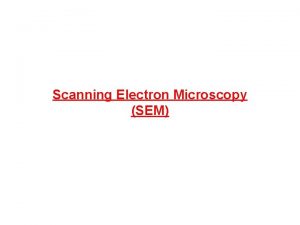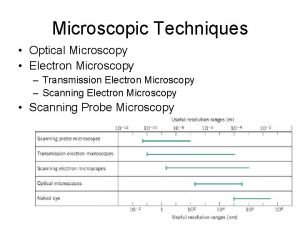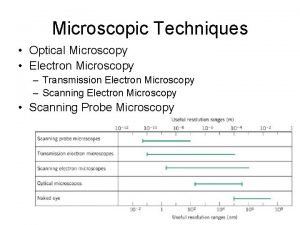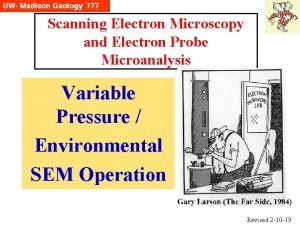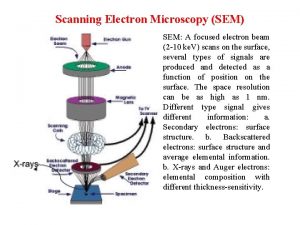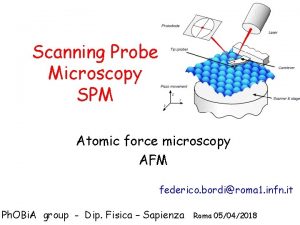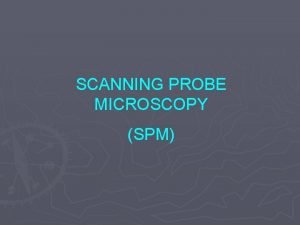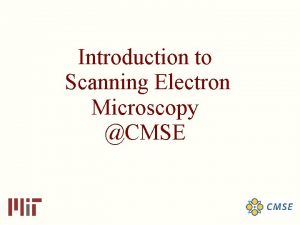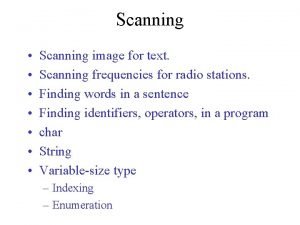Introduction to scanning electron microscopy Tutor Peter Harris



















- Slides: 19

Introduction to scanning electron microscopy Tutor: Peter Harris The aims of this course are: ● to introduce the principles of scanning electron microscopy ● to describe the components of the microscope and explain how they work ● to highlight some of the problems which can arise during imaging Click on the buttons to move between slides. (Make sure you are in “Slide Show” mode) Electron Microscopy Lab

Introduction to scanning electron microscopy Overview Ø Scanning electron microscopy is a technique for achieving high resolution images of surfaces. It involves scanning a fine beam of electrons over a specimen and detecting the signals which are emitted. Ø The resolution of modern SEMs is of the order of 2 nm. This compares with a resolution of about 1 m for a conventional optical microscope. The transmission electron microscope (TEM), in which electrons pass through a very thin sample, has a higher resolution than the SEM (~ 0. 1 nm). Individual atoms can be imaged in the TEM but not the SEM. Ø Imaging in the SEM must be carried out under vacuum, as electrons cannot travel through air. The basic components of the SEM are illustrated on the next slide. Units: 1 nm = 10 -9 m; 1 m = 10 -6 m Electron Microscopy Lab

Introduction to scanning electron microscopy Components of the SEM Electrons emitted by the gun are accelerated, typically by 20 k. V. They pass through condenser and objective lenses, and then through a set of scan coils and an aperture. A scan is simultaneously generated on a computer monitor. Electrons emitted by the specimen are detected, amplified and the signal is then used to produce an image. Electron Microscopy Lab

Introduction to scanning electron microscopy Electron sources A number of different kinds of electron source are used in SEM. The microscopes in EMLab use the following sources: Tungsten thermionic source This is simply a very fine tungsten wire, through which a current is passed. Characteristics Ø Low brightness Ø Energy spread ~ 1 -2 e. V Schottky Field Emission Source This is a crystal to which a very high voltage is applied. Characteristics Ø High brightness Ø Energy spread < 0. 5 e. V Electron Microscopy Lab

Introduction to scanning electron microscopy Electromagnetic lenses All modern SEMs use electromagnetic lenses. These consist of a coil of copper wires inside iron pole pieces. solenoid of wire together with a magnetic pole piece that creates and concentrates a magnetic field. A current through the coils creates a magnetic field, symbolized by red lines in the diagram on the left. Electrons close to the centre are less strongly deflected than those passing through the lens far from the axis. Electron Microscopy Lab

Introduction to scanning electron microscopy Interaction of electrons with specimen When high energy electrons impinge on the specimen, a number of signals are generated: ● Backscattered electrons – these are high energy electrons which are scattered out of the specimen, losing only a small amount of energy. ● Secondary electrons – these originate in the specimen itself, and have a much lower energy than the backscattered electrons (typically < 50 V). ● X-rays - These give information about the elemental composition of the sample. Electron Microscopy Lab

Introduction to scanning electron microscopy Information given by secondary and backscattered electrons Secondary electrons originate from within a few nm from the surface. They are therefore very sensitive to surface structure, and provide topographic information. Backscattered electrons originate from much deeper within the sample (a few m below the surface), and interact much more strongly with the sample. They therefore provide compositional information, but give lower resolution images. Electron Microscopy Lab

Introduction to scanning electron microscopy Detectors: secondary electrons The detector for secondary electrons is the Everhart Thornley Detector (ETD). This consists of a scintillator that emits photons when hit by high-energy electrons. The emitted photons are collected by a lightguide and transported to a photomultiplier for detection. A metal grid known as a Faraday cage surrounds the scintillator, and is usually held at a positive potential to attract the secondary electrons. Electron Microscopy Lab

Introduction to scanning electron microscopy Origin of topographic contrast in secondary electron images Many 2 ndary electrons escape Fewer 2 ndary electrons escape Sample In order to obtain an image in the SEM, we must have some variation in the signal from different parts of the specimen. The yield of secondary electrons is at a minimum when the surface of the specimen is perpendicular to the electron beam. This is because of the shape of the interaction volume and its relationship to the surface of the specimen, as shown here. At regions of the specimen which are not exactly perpendicular to the beam, electrons are more likely to be scattered out of the specimen, rather than further into the specimen. Hence, such regions appear bright in the secondary electron image. Electron Microscopy Lab

Introduction to scanning electron microscopy Detectors: backscattered electrons Backscattered electrons can be detected using an Everhart Thornley detector, by applying a negative potential to repel the secondaries. However, the collection efficiency of such an arrangement is low. As the name suggests, backscattered electrons are strongly scattered back in the direction of the incident beam. Therefore, the detector for these electrons is generally placed around the final lens, as shown. Backscattered electron detectors are usually solid state devices. The electrons which impinge on the detector produce electron-hole pairs which produce a current which can be amplified. Electron Microscopy Lab

Introduction to scanning electron microscopy Resolution in the SEM Ø The resolution of the SEM is determined by the size of the incident beam. This can be reduced by introducing an aperture unto the beam path and by reducing the probe size using the condenser lens. Note that reducing the probe size using the condenser lens also reduces the beam current (for an explanation, see Goodhew et al. , p. 131). Therefore, as you reduce the probe size you eventually reach a point where imaging is impossible. For a typical SEM operating at 20 k. V, the minimum usable probe size is of the order of 1 – 3 nm. Ø Resolution also depends on accelerating voltage. This is because higher energy electrons experience less spherical aberration when they pass through the lenses. Resolution is also improved by reducing the working distance, up to a certain point. Beyond that point the lenses may not be able to focus the beam on the sample. Ø As already noted, images obtained with backscattered electrons have a lower resolution than these obtained with secondary electrons, because they originate from deeper within the specimen. Electron Microscopy Lab

Introduction to scanning electron microscopy Depth of field 1 Depth of field is the distance above and below the plane of optimum focus within which the image is in focus. In the diagram on the right, d represents the diameter of the electron beam at the specimen. The depth of field is h, since it makes no difference to the sharpness of the image if the object is anywhere within the range h. Reducing the angle α increases the depth of field. This can be achieved by using a smaller aperture or by increasing the working distance. Electron Microscopy Lab

Introduction to scanning electron microscopy Depth of field 2 These diagrams illustrate the effect of the convergence angle α on the depth of field. Because of the geometry of the imaging system, scanning electron microscopes have a much greater depth of field than optical microscopes. Electron Microscopy Lab

Introduction to scanning electron microscopy Astigmatism 1 Astigmatism is a problem that is commonly encountered in SEM (and TEM). It is an aberration of lenses that causes rays in a plane parallel to the optical axis to be focused at a different focal point from rays in a plane at 90° to it. The effect of astigmatism is that objects in the image generally appear “stretched” in one direction, and then in the other direction as you go through focus. All electron microscopes are equipped with stigmators, which allow the user to correct the astigmatism, as shown in the next slide. Properly corrected astigmatism is essential in achieving high resolution images. Electron Microscopy Lab

Introduction to scanning electron microscopy Astigmatism 2 The SEM images shown below left illustrate how astigmatism affects the image as you go through focus. On the right is shown the image following correction with the stigmators. Astigmatic Corrected Electron Microscopy Lab

Introduction to scanning electron microscopy Spherical aberration is less important in the actual operation of the SEM than astigmatism, but it is important to understand what it is. A lens suffers from spherical aberration if it focuses rays more tightly if they enter it far from the optic axis than if they enter closer to the axis. It therefore does not produce a perfect focal point. This is illustrated in diagram A on the right. Electron Microscopy Lab

Introduction to scanning electron microscopy Chromatic aberration Like spherical aberration, this is not usually a major problem in SEM, except in high resolution or low voltage operation. It is caused by a lens having a different refractive index for different electron energies. Chromatic aberration is present in all electron lenses, but can be reduced by minimising the energy spread of the electron source. Field emission sources have the lowest energy spread. Electron Microscopy Lab

Introduction to scanning electron microscopy Charging When a poorly conducting specimen is imaged in a conventional SEM, the surface rapidly accumulates charge. This can result in a severely distorted image, as the incident electrons are repelled by the charged areas of the surface. A typical feature of charging is that some regions appear extremely bright, as can be seen here. In order to avoid this problem, specimens can be covered with a conducting coating of gold or carbon. Coating with a heavy metal such as gold also has the beneficial effect of increasing the yield of secondary electrons from the specimen. An alternative to coating is to use a “low vacuum” SEM. This kind of microscope operates with a small pressure of water vapour in the chamber. The water molecules become positively charged and neutralize the negatively charged regions on the surface. Electron Microscopy Lab

Introduction to scanning electron microscopy Further information Ø The recommended book for this course is "Electron microscopy and analysis", by Goodhew, Humphreys and Beanland. Ø Links to some useful websites can be found on the “SEM course” page. Ø Peter and Amanpreet will be happy to answer your questions. Electron Microscopy Lab
 Microscopy tutor
Microscopy tutor Microscopy tutor
Microscopy tutor Microscopy tutor
Microscopy tutor Microscopy tutor
Microscopy tutor Advantages of scanning probe microscope
Advantages of scanning probe microscope Scanning thermal microscopy
Scanning thermal microscopy Afm mfm tutorial
Afm mfm tutorial Electron microscopy data bank
Electron microscopy data bank Sssshhssss
Sssshhssss Digital design and computer architecture
Digital design and computer architecture Tem vs sem
Tem vs sem Scanning electron
Scanning electron Scanning electron microscope main idea
Scanning electron microscope main idea Advantages of microscope
Advantages of microscope Disadvantages of phase contrast microscope
Disadvantages of phase contrast microscope Vibrio cholerae stool microscopy
Vibrio cholerae stool microscopy Amorphous phosphate in urine
Amorphous phosphate in urine Provider-performed microscopy procedures examples
Provider-performed microscopy procedures examples Fazekas scale
Fazekas scale Branches of microscopy
Branches of microscopy
